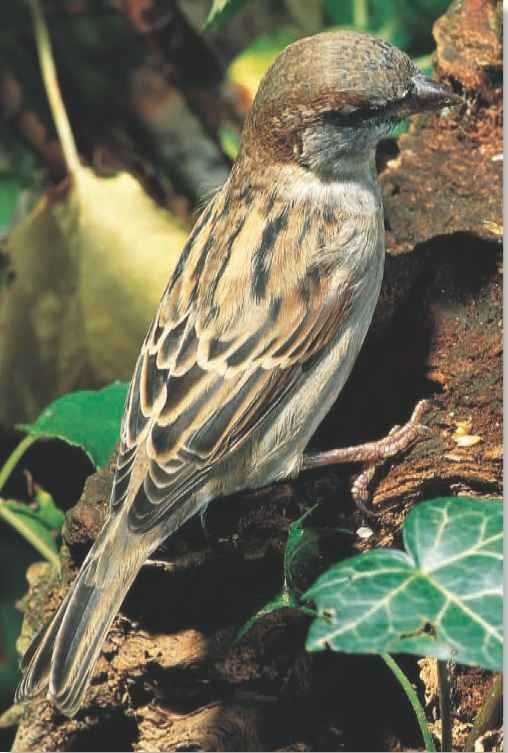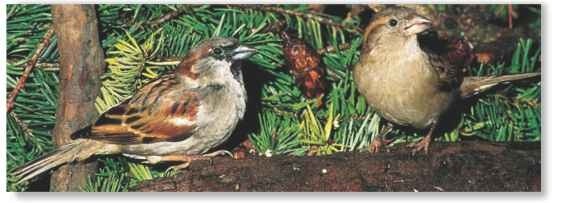ORDER
Passeriformes
FAMILY
Passeridae
GENUS & SPECIES
KEY FEATURES
• One of the world’s
most widespread and successful songbirds
• Able to live in every habitat within its
range, except for dry deserts, thick forests and mountain peaks
• Enjoys a closer relationship with humans than does almost any other species of bird, and has actually benefited from the growth of cities and towns
WHERE IN THE WORLD?
Formerly restricted to North Africa and
Eurasia,-but has spread throughout the world during the
last 150 years; now represented on six . continents; absent only from polar extremes
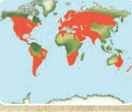
Lifecycle
Most animals are made homeless when their habitats are replaced by farmland and towns — but the house sparrow has benefited greatly from cultivation and urbanization.
HABITAT
Few parts of the world are too hot, cold, wet or dry for the house sparrow. It is found well above the Arctic Circle in Scandinavia, and at the equator in South America and eastern Africa.
But the species was not always so widespread. Until the early 19th century the sparrow was confined to lowlands in southern and central Eurasia and to a few parts of North Africa. Since then,urbanization and the planting of cereal crops, like wheat, have enabled this grain eater to colonize much of the world.
World resident The sparrow can survive almost anywhere.

The house sparrow has learned that insects trapped in spiders’ webs and car radiators make an easy meal.
The house sparrow annoys gardeners by tearing and shredding yellow flower petals, for which it has a fondness.
BEHAVIOR
It is unusual to see a house sparrow on its own; the species feeds in parties, breeds in loose colonies and roosts communally. One reason for flocking together is to increase the chance of spotting danger
Additionally, since each sparrow in the flock spends less time checking for predators, it can feed longer. The house sparrow has many enemies, even in towns; a large number of nestlings and j uveniles falls victim to cats.
Breeding sparrows sleep near the nest. At other times, they assemble in huge numbers at favored sites: a roost in Egypt housed about 100,000 birds. By repeating a chirping call, a flock of roosting sparrows is capable of producing a deafening noise.
The house sparrow frequents many dusty habitats, so it must clean its plumage regularly. Flocks often settle to bathe in park lakes, fountains and puddles. The sparrow also takes dust baths, flicking sand and soil with
its wings, to remove parasites. Occasionally it perches on the rim of a chimney to expose its feathers to the smoke.
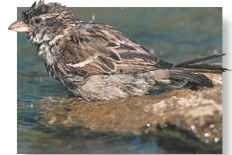
Top seed The house sparrow is a pest in some regions due to its eating habits.
BREEDING
FOOD & FEEDING
The house sparrow feeds mainly on grass seeds, herbs, wildflowers and cereal crops, especially wheat, barley, oats, millet and sorghum. It gathers food by pecking on the ground, but also tugs the seeds from low-growing plants and perches on ripe seed heads to strip them. Large flocks gather to feast in ripening corn fields, becoming a pest and occasionally destroying whole crops. Flocks also raid grain stored at farmyards, railway depots and ports, even stealing food from cattle in winter.
The house sparrow is an opportunist, quick to exploit any source of food. Depending on the season, it nibbles at fresh plant shoots and buds, extracts the sweet pulp from fruits and hunts insects.
In urban areas, food is plentiful all year The house sparrow scavenges a wide range of scraps from shops, markets, parks and open-air cafes; it also visits bird feeders to take the food put out by humans. Indeed, some city-dwelling sparrows eat almost no “natural” food at all.

CONSERVATION
The house sparrow continues to expand its range alongside human expansion, especially in South America and oceanic islands. But in Britain, flock numbers have dropped from 19 birds in 1970 to 12 in 1995.’
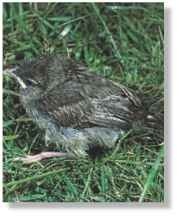
A One of many In favorable conditions a female sparrow can raise seven broods in a year.
The house sparrow breeds in colonies of 10-20 birds. Nest sites vary from cliff faces to windowsills and rooftops.The sparrow may also take over the old nests of other birds; whole colonies can fit inside the bulky nests of herons or storks.
Both parents incubate the clutch of up to five eggs.To feed the chicks, the parents regurgitate a partly digested mixture of seeds and insects into the nestlings’ bills. The young leave the nest after
2-3 weeks, when they learn to fly, but still beg food from their parents. After five weeks, the young become independent.
Pair-bond Both parents contribute to raising young.
HOUSE PARTY
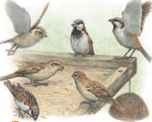
Guests arrive…
A flock has discovered a garden bird feeder laden with seeds.The sparrows help themselves to this lucky find.
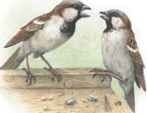
Confrontation…
The sparrows squabble, jostling each other for the best positions. With his bill agape, one male threatens a rival.
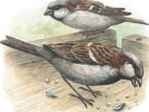
Top feeder…
The aggressive sparrow’s threat display and large bib keep the smaller-bibbed male away from the prime feeding spot.
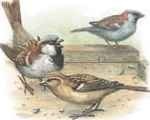
Bonus
The top male gets the pick of the food and attracts the female, while the less showy male is left hungry and without a mate.
PROFILE
House Sparrow
With a versatile, powerful bill and a broad diet, the resourceful house sparrow manages to thrive in a variety of habitats.
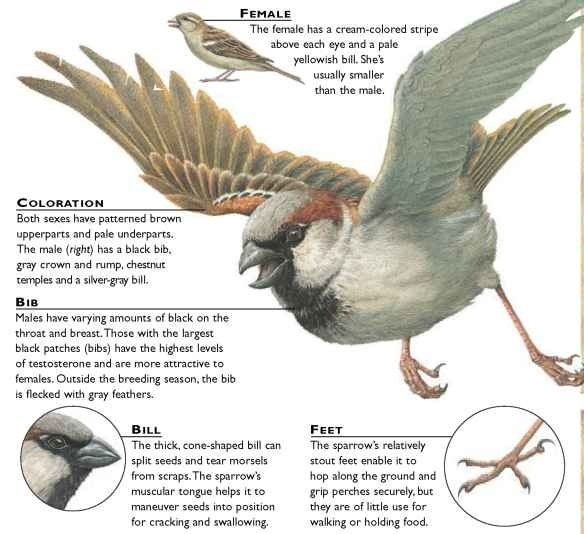
CREATURE COMPARISONS
A bird of arid, sandy habitats, the golden sparrow (Passer luteus) is found in Africa from Mauritania and Senegal to southern Egypt, Sudan and Eritrea, with a smaller population in the Middle East.
The male has a yellow head, breast and belly, and his back is yellow (Arabian) or red-brown (African).The female is paler than the male, but is bright enough to make the female house sparrow seem drab by comparison.The golden sparrow is about 15% smaller than the house sparrow, with a shorter gray bill that turns black during the breeding season.
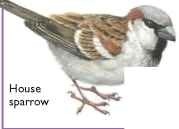

Golden sparrow
| VITAL STATISTICS | |
| Weight | 0.85-1.33- oz. |
| Length | 5.5-6″ |
| Wingspan | 8.5-10″ |
| Sexual Maturity | 1 year |
| Breeding Season | Spring and summer; all year in tropics |
| Number ; of Eggs | 3-5 per clutch |
| Incubation Period | 9-18 days |
| Fledging Period | 11-19 days |
| Breeding Interval | 2-4 broods a year; up to 7 a year in tropics |
| Typical Diet | Seeds, berries, buds, insects; refuse scraps |
| Lifespan | 1-5 years |
RELATED SPECIES
• The sparrow family, Passeridae, contains 34 species in 3 genera: the house sparrow and 20 other species in the genus Passer, 6 species of rock and bush sparrow in the genus Petronia and 7-species of snow finch in the genus Montifringilla. Sparrows are related to weavers, queleas, bishops and fodies. As a family, they are generally brown or gray, with short legs and poor singing ability.
